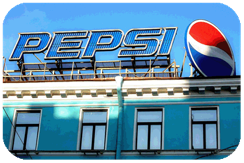 Throughout Pepsico’s history, one thing has remained constant: the company’s flagship soft drink has always played second fiddle to chief competitor Coca-Cola. Known by name by billions throughout the world, Coke is not only the gold standard of soft drinks, but of branding in general. Although Pepsi and its umbrella of products certainly command a fair market share, Coca-Cola’s continued worldwide dominance is all but assured at this point.
Throughout Pepsico’s history, one thing has remained constant: the company’s flagship soft drink has always played second fiddle to chief competitor Coca-Cola. Known by name by billions throughout the world, Coke is not only the gold standard of soft drinks, but of branding in general. Although Pepsi and its umbrella of products certainly command a fair market share, Coca-Cola’s continued worldwide dominance is all but assured at this point.
Except in Russia, that is. Pepsi was one of the first big Western companies to do business in the country, opening its first soda plant in 1974 on what was then Soviet soil. With $5 billion in annual revenue, Russia accounts for Pepsi’s second-largest market after the U.S. But Pepsi isn’t satisfied with simply selling soda in the region. Over the last few years the company has been snatching up local beverage and food makers in order to take control of the former Soviet Bloc’s snack market. For instance, two years ago Pepsi paid $4.2 billion for the Russian yogurt giant Wimm-Bill-Dann Foods. Before that, it acquired Russia’s largest juice company for nearly $2 billion.
With sales in Europe stale and the Chinese market becoming increasingly competitive, the growing middle class of Russia and environs present Pepsi with their best opportunity for growth. But despite the company’s established presence in the region, converting the populace into a legion of packaged-snack patrons will be a challenge. Americans have no qualms with purchasing packaged snacks, consuming as much as $34 billion worth per year. In Eastern Europe, however, people primarily make their own snacks, such as homemade compote juice or crackers made from stale bread. Pepsi hopes to win over these consumers by marketing “value-added” products like vitamin-enriched juice or drinkable yogurts. Only time will tell if Russians elect to adapt to this Western manner of snacking or stick with their more traditional ways.
Questions:
- What advantage does Pepsi have in approaching a new market in Russia?
- What two factors do both Pepsi and Coke need to remember about global markets?
Source: Duane Stanford, “PepsiCo’s Eastern European Snack Attack,” Bloomberg BusinessWeek, February 28, 2013. Photo courtesy of Mary Do.
